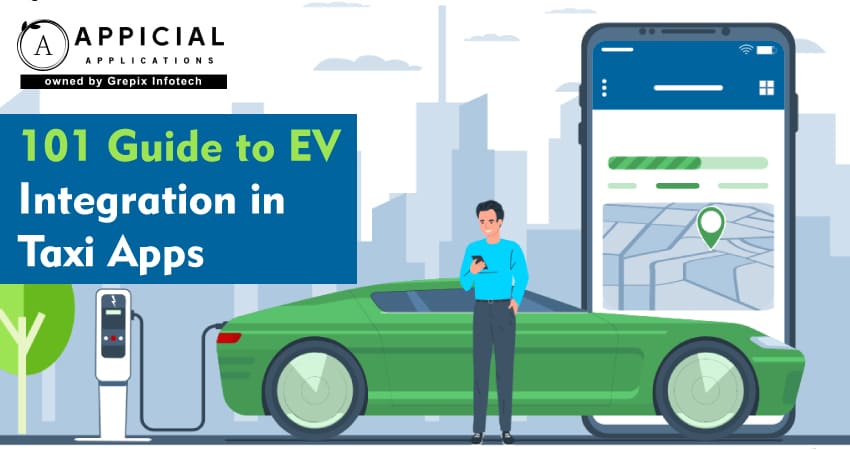
101 Guide to EV Integration in Taxi Apps
EV Integration in Taxi Apps: Everything You Need to Know
You’ve probably noticed it. The streets are quieter. The air smells a little cleaner.And every once in a while, a sleek, silent vehicle zips by. That’s no coincidence!
Electric cars (EVs) are revolutionizing the way we get around, particularly in ride-sharing. And they're not just a fad.And guess what, they’re necessary!
According to the International Energy Agency, over 18% of new car sales in 2023 were electric, up from just 4% in 2020.So it’s only natural that the next wave of ride-hailing apps will be electric. Welcome to the era of the EV taxi app. Let’s dive deep into how this green evolution transforms the taxi industry.
The rise of EV taxi apps is transforming urban mobility with cleaner, smarter, and more sustainable rides. This guide explores the benefits of integrating electric vehicles into taxi services, including reduced operational costs, government incentives, and enhanced eco-branding. It also outlines key strategies like fleet electrification, smart routing, and battery management. With trends like autonomous EVs and carbon credit systems on the horizon, green mobility is no longer optional—it’s the future. For businesses looking to build an eco-friendly taxi platform, now is the time to act. Partner with experts to launch a scalable, EV-ready app solution.
What are the Key Benefits of EV Taxi Apps?
There is no denying the fact that integrating electric vehicles into taxi services isn’t just good for the planet, it’s smart business.
1Minimized Operational Costs
Electric cars are cheaper to run. A typical EV costs about half as much per mile compared to gasoline cars. Drivers save big on fuel and maintenance.
2Eco-Friendly Branding
People want to support businesses that care. An eco-friendly taxi service signals responsibility. It earns trust. And in many cases, it boosts bookings. For instance, Climatecars in London operates a fleet of hybrid and electric cars, with emissions as low as 71g/km, compared to 233g/km for traditional black taxis. (Source: Wikipedia).
3Government Incentives
Governments around the world are offering generous incentives such as subsidies, tax breaks, and grants for EV charging infrastructure. Thus, it’s a good opportunity for both startups and established taxi companies to transition to electric vehicle fleets and capitalize on the growing demand for sustainable transportation.
4Clean Air, Healthy Cities
More EVs mean less tailpipe pollution. That means fewer asthma cases, fewer respiratory issues, and healthier urban communities. Thus, it’s a win-win situation in terms of both environment and cost savings.
5Regulatory Compliance
Cities like London, Paris, and New York are cracking down on CO2 emissions. EVs help fleets stay ahead of evolving laws and avoid fines. Furthermore, it’s wise to collaborate with tech companies and government bodies can accelerate EV integration. For example, WeRide's partnership with Uber aims to introduce robotaxis in 15 cities to enhance safety and scalability. (Source: Business Insider).
So yes, green mobility isn’t just about being kind to nature. It’s about staying competitive in a shifting market.
1Implementation Strategy: Bringing EVs into Taxi Apps
Thinking of launching an EV taxi app? Or converting your existing fleet? Here's a list of the steps included under the implementation strategy.
1Fleet Electrification Planning
In the first step, you will need to assess your current fleet size, routes, and average daily mileage. EVs are great, but not all models suit long-distance or rugged terrain. Choose electric models based on use case. For city rides, compact EVs work well. For longer trips, consider models with 300+ miles of range.
2Charging Infrastructure Partnerships
A major hurdle for EV taxi drivers is charging downtime. Form partnerships with local charging networks like ChargePoint or Electrify America. Better yet, invest in private charging hubs at taxi depots. Fast-charging stations can reduce downtime and keep the fleet running.
3Battery Management Integration
Remember that your app should include real-time battery status for each vehicle. This allows automated route assignment, ensuring EVs aren’t assigned trips they can’t complete. Smart routing also helps drivers find nearby charging points when needed.
4Driver Onboarding & Training
EVs drive differently. Regenerative braking, silent motors, and charging protocols—these are new for most drivers. Run workshops, create onboarding guides, and support drivers during the transition. Confident drivers mean better service.
5App Optimization for EVs
Your EV taxi app must support EV-specific features. This includes:
- Live battery tracking
- Trip estimation based on charge
- Nearest charging station locator
- Incentives for low-emission trips
6Partner with Green Energy Providers
Powering EVs with coal-generated electricity defeats the purpose. Team up with green energy suppliers to truly offer zero-emission rides. Apps can highlight “100% renewable” rides as a badge of honor.
7Incentivize Users & Drivers
Reward eco-conscious behavior. Give riders discounts for choosing an eco-friendly taxi. Offer bonuses to drivers who complete a set number of green rides. Gamification boosts adoption.
8Compliance with Local Policies
Make sure your rollout aligns with local and national EV guidelines. Some cities require permits, inspections, or minimum EV quotas for fleet operators. Stay ahead of the paperwork.
User & Driver Experience: What Changes?
Let’s talk about the people using your app. Both riders and drivers.
1Rider Experience
- Silent Rides: No engine noise. Just peace. Riders appreciate the quiet.
- Cleaner Air: Especially noticeable in cities. Zero emissions mean no fumes at pickup.
- Modern Features: Most EVs have in-cabin tech—climate control, infotainment, wireless charging. Riders feel like VIPs.
- Environmental Impact Display: Let users see how much CO2 they saved per ride. It creates emotional value.
- EV Preferences: Let users choose “green rides” as their default. Think of it as choosing a meal type on a flight.
2Driver Experience
- Lower Fuel Costs: No more painful gas station visits. Many drivers cut monthly fuel expenses in half.
- Less Maintenance: No oil changes. Fewer moving parts. Downtime goes down. Income goes up.
- Charging Management: Integrated app features help drivers find available chargers, schedule downtime, and avoid peak hours.
- Pride in Purpose: Many drivers report higher job satisfaction knowing they’re contributing to green mobility.
In short, the transition doesn’t just benefit the business. It transforms the experience for everyone involved.
Also Read: The Future of Mobility: Predictions for the Next Decade
Future Trends in EV Taxi Apps
The road ahead is even more exciting. Let’s explore where ev taxi app tech is heading.
1AI-Powered Smart Routing
With real-time battery data, traffic analytics, and trip history, AI can predict optimal routes, balance charging schedules, and even cluster pickups for efficiency. This means lower wait times, faster trips, and less battery stress.
2Autonomous Electric Taxis
Companies like Waymo and Tesla are already testing self-driving EVs. While full autonomy may still be a few years out, semi-autonomous features like autopilot for highways are becoming standard. These could dramatically lower labor costs in the future.
3Integration with Smart Cities
Smart cities of tomorrow will have EV lanes, dynamic traffic signals, and automated EV-only parking zones. Taxi apps will tap into these systems to optimize rides further.
4Battery-as-a-Service (BaaS)
Instead of owning batteries, operators may lease them. When the battery drains, drivers can swap it at stations in minutes. This eliminates charging delays entirely. Companies like NIO are already pioneering this model in Asia.
5Carbon Credit Integration
Future eco-friendly taxi fleets could earn carbon credits for their emission-free trips. These credits can be traded or reinvested, creating a new revenue stream. Apps may show riders how their ride contributed to a cleaner planet in real-time.
6Super Apps with Green Features
Apps like Grab and Gojek are evolving into super apps. Future EV taxi apps may integrate food delivery, grocery runs, and carpooling, powered entirely by EVs. All services, one green app.
7Integration with Public Transport
Future green mobility platforms will not exist in silo. Rather, EV taxi apps will be a part of integrated mobility-as-a-service (MaaS) platforms that provide seamless multi-modal travel choices, integrating EV taxis, e-bikes, buses, and metro systems.
8Expansion into Rural and Suburban Markets
Even though electric vehicles are at present more prevalent in cities, integrating EV taxi app services into rural and suburban areas can contribute to filling mobility gaps as well as providing sustainable transportation avenues outside of urban areas.
Let’s take a quick look at the table summarizing these trends:
| Future Feature | Impact on EV Taxi Ecosystem |
|---|---|
| AI-Powered Routing | Smarter trips, longer battery life |
| Autonomous Driving | Lower costs, 24/7 fleet operations |
| Smart City Integration | Seamless, traffic-free EV rides |
| Battery-as-a-Service | Instant battery swaps, reduced downtime |
| Carbon Credit System | Financial incentive for eco-friendly rides |
| Super App Evolution | One-stop green mobility platform |
Wrapping Up
So, there you have it! That’s a wrap to the EV integration in taxi apps! It is no secret that EVs aren’t coming. They’re here. And their integration into ride-hailing is not just a trend, it’s the future of urban transport.
Whether you're a startup entering the EV taxi app fray for the first time or an incumbent operator considering switching to electric, the opportunity is huge. For startups and incumbent transport firms alike, investing in an EV taxi app isn't merely a good business decision—it's a matter of survival in a planet that's speeding towards sustainability. From cost savings and operational effectiveness to environmental stewardship and customer satisfaction, the advantages are too compelling to ignore.
The road ahead is electric. And for taxi apps ready to embrace this journey, the road to green mobility has never been clearer or more urgent.
So, if you're planning to create an eco-friendly taxi app that's future-proof, the time is now, and outsource the job to a professional taxi app development agency like Appicial! We are a committed taxi mobile app development company that creates stable, scalable, and feature-laden apps that can attract users and convert them into your prospective customers.
To learn more, simply visit Appicial and our experts will contact you shortly!
Looking out to start your own venture like Uber ? Try out our HireMe Taxi Uber Clone, the easiest way to kick-start your taxi business.
Author's Bio

Vinay Jain is the Founder at Grepix Infotech and brings over 12 years of entrepreneurial experience. His focus revolves around software & business development and customer satisfaction.
Back to blog list




